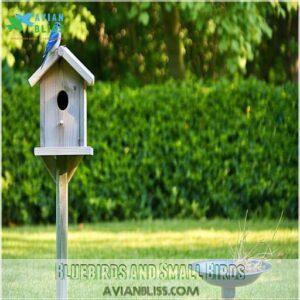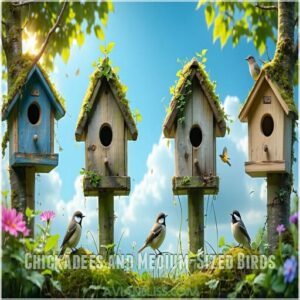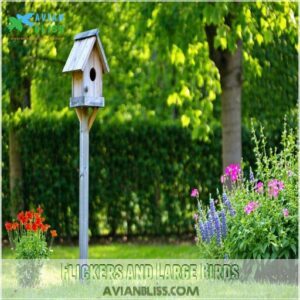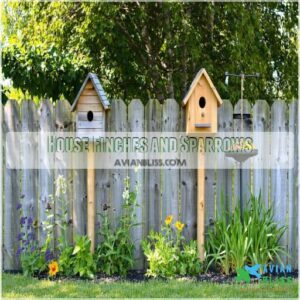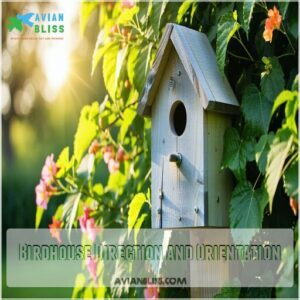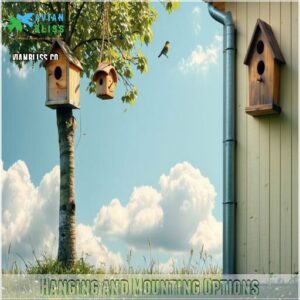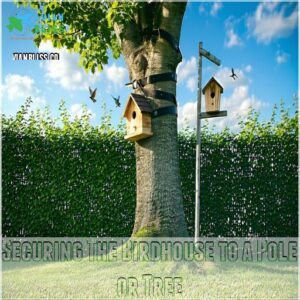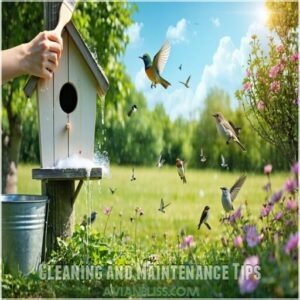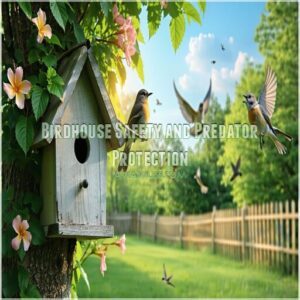This site is supported by our readers. We may earn a commission, at no cost to you, if you purchase through links.
 You’ll find success with your bird house installation guide by focusing on three key factors: location, height, and protection.
You’ll find success with your bird house installation guide by focusing on three key factors: location, height, and protection.
Position your birdhouse away from prevailing winds, with entrances facing away from afternoon sun. Mount it 4-15 feet high depending on your target species—bluebirds prefer 4-6 feet, while chickadees like 5-15 feet.
Keep birdhouses 20-30 feet from feeders and water sources, and choose mounting options like poles or trees based on both aesthetics and bird preferences.
Just like finding the perfect apartment, birds have their preferences too! Wait until you discover which unexpected visitors might make themselves at home in your carefully placed new digs.
Table Of Contents
- Key Takeaways
- Choosing The Right Birdhouse Location
- Mounting Heights for Different Bird Species
- Birdhouse Direction and Orientation
- Birdhouse Installation and Maintenance
- Attracting The Right Bird Species
- Birdhouse Safety and Predator Protection
- Post-Installation Tips and Considerations
- Frequently Asked Questions (FAQs)
- Where not to put a bird house?
- Should I put anything inside a birdhouse?
- Which direction should a bird house face?
- How high off the ground should a birdhouse be?
- Which direction should a bird house opening face?
- How can I prevent birdhouse moisture buildup?
- What materials are best for birdhouse insulation?
- Can birdhouses be painted brightly?
- How to ensure proper ventilation in a birdhouse?
- Are there DIY pest control methods for birdhouses?
- Conclusion
Key Takeaways
- You’ll need to mount your birdhouse 4-15 feet high depending on the species, with bluebirds preferring 4-6 feet and chickadees favoring 5-15 feet for optimal nesting conditions.
- Position your birdhouse entrance facing east or away from prevailing winds to protect against storms, while ensuring morning sun exposure without afternoon overheating.
- Keep your birdhouse at least 20-30 feet away from feeders and water sources to prevent predator attraction and reduce competition between nesting birds.
- You’ll want to regularly clean and maintain your birdhouse by removing old nests, checking for damage, and adding proper insulation during winter to ensure year-round habitability.
Choosing The Right Birdhouse Location
Picking the right spot for your birdhouse isn’t just about looks—it’s about safety and comfort. Place it where birds feel secure, away from predators and harsh weather.
Considerations for Bird Species
Understanding bird species’ nesting preferences is key to creating a welcoming habitat. Each bird has unique needs, so pick the right species-specific design to match their habitat needs.
- Bluebirds thrive in open spaces; use a birdhouse for bluebirds with a 1.5-inch entrance hole.
- Chickadees prefer wooded areas and a 1.25-inch hole in their birdhouse for chickadees.
- Wrens enjoy cozy, enclosed spaces; a birdhouse for wrens suits them perfectly.
Always consider food sources and predator avoidance!
Placement in Relation to Wind and Sun
Keeping birds comfy starts with smart birdhouse placement. Face the entrance away from prevailing winds for rain protection and a snug shelter.
An east-facing opening lets in morning sun without overheating in the afternoon. Balance is key: warmth, shade, and safety.
| Factor | Best Practice | Why It Matters |
|---|---|---|
| Wind Direction | Away from prevailing winds | Blocks rain, reduces drafts |
| Sun Exposure | Morning sun, afternoon shade | Regulates temperature |
| Birdhouse Location | Sheltered, open spaces | Combines safety and comfort |
Proximity to Feeders and Water Sources
Your birdhouse deserves a peaceful neighborhood.
Placing it too close to bird feeders or water sources can create issues like predator attraction, competition for resources, and even disease transmission. Birds need a calm environment to nest and thrive.
Here’s how to guarantee the best spot for your birdhouse:
- Keep distance: Place birdhouses at least 20-30 feet from feeders or water sources.
- Avoid overcrowding: Too many birdhouses in one area can stress birds.
- Space reduces predator risks and keeps nesting birds secure.
Proper birdhouse placement balances proximity to and water while guaranteeing a quiet, safe environment. Your feathered friends will appreciate the thoughtful setup!
Mounting Options for Different Birds
Mounting birdhouses can feel like a balancing act, but it’s simpler than you think.
Pole mounting offers stability and keeps predators guessing. Prefer a rustic vibe? Try tree hanging, but don’t forget a baffle for extra defense.
For urban charm, consider wall attachment or fence installation. Need height? Roof placement works wonders.
When choosing a mounting method, consider the importance of proper Pole Mounting Kits.
Check out this quick birdhouse mounting guide below:
| Mounting Option | Benefits | Best For |
|---|---|---|
| Pole Mounting | Predator protection | Bluebirds, Wrens |
| Tree Hanging | Natural look, easy access | Chickadees, Finches |
| Wall Attachment | Urban-friendly | Sparrows, House Wrens |
Mounting Heights for Different Bird Species
Getting the height right for your birdhouse can make all the difference for attracting birds.
Each species has specific preferences, so placing it too high or low might leave it empty.
Bluebirds and Small Birds
Bluebirds and other small birds, like House Finches, are picky about where they nest.
A birdhouse for bluebirds needs thoughtful placement to match their preferences.
Follow these birdhouse placement tips to create a welcoming home:
- Mount small birdhouses 4-6 feet high for ideal safety and comfort.
- Keep the entrance hole exactly 1½ inches wide to suit bluebird behavior.
- Add predator guards, like baffles, to protect nesting birds.
- Choose open spaces, away from feeders, to reduce competition.
Regular cleaning and offering nesting materials promote feather care and attract birds during migration.
A little effort makes your birdhouse irresistible!
To maximize attraction, consider ideal birdhouse design for your target species.
Chickadees and Medium-Sized Birds
Chickadees love a cozy, well-placed home! Install their birdhouses 5-15 feet high for easy access.
Use a 1.25-inch entrance hole to match their size and keep larger birds out. Space each box about 650 feet apart for peace and privacy.
Add soft nesting materials like moss or feathers to attract them. With careful birdhouse placement tips, you’ll enjoy their charming antics daily!
| Feature | Ideal Specification | Purpose | Fun Fact |
|---|---|---|---|
| Entrance Hole Size | 1.25 inches | Keeps predators out | Chickadees love snug spaces! |
| Mounting Height | 5-15 feet | Safe from predators | They’re expert acrobats! |
| Spacing Between Boxes | 650 feet | Reduces territorial fights | Chickadees are territorial! |
| Nesting Materials | Moss, feathers | Encourages nesting | They add their own flair! |
Flickers and Large Birds
Flickers, those charismatic woodpeckers, appreciate a cozy, roomy space to call home.
A birdhouse for flickers should sit 6-10 feet high and measure about 7x7x18 inches.
Keep their needs in mind:
- Include drainage and ventilation to maintain comfort.
- Use sturdy materials for bird safety and durability.
- Install on a birdhouse pole mounting to deter predators.
- Expect drumming—it part of flicker habits!
This birdhouse installation guide guarantees your nesting boxes meet all their woodpecker needs.
House Finches and Sparrows
House finches and sparrows bring charm to your yard with their unique nesting habits.
Install a birdhouse for finches 5-10 feet high and one for sparrows 10-15 feet up. These social birds thrive in close-knit neighborhoods, so spacing isn’t a big deal.
Finches adore seeds, while sparrows enjoy a diverse menu. Keep their birdhouses sturdy to handle their energy.
Use this quick reference:
| Bird | Height | Nesting Habits | Diet | Bird Attractants |
|---|---|---|---|---|
| Finch | 5-10 ft | Social | Seeds | Native plants |
| Sparrow | 10-15 ft | Active | Mixed | Bird feeders |
Birdhouse Direction and Orientation
Pointing your birdhouse in the right direction can make all the difference for nesting birds.
By considering wind, sun, and temperature, you’ll create a safe, comfortable home they’ll love.
Importance of Entrance Hole Direction
The way you position the birdhouse entrance hole can shape a bird’s entire nesting experience.
Aim for a direction that offers wind protection while ensuring sun exposure during cooler mornings.
Think of it as finding the perfect balance between cozy warmth and shelter from storms.
A poorly placed entrance could invite predators or leave the nest vulnerable to harsh weather.
For better bird safety and nesting success, prioritize thoughtful birdhouse plans and designs that align with your birdhouse mounting strategy.
Considerations for Prevailing Winds
When planning your birdhouse installation, don’t overlook wind direction.
Positioning the entrance hole away from prevailing winds provides better storm protection and weather resistance for nesting birds.
Think of it like choosing a cozy corner for your home—no one wants gusts blowing through!
This placement improves airflow while keeping rain and debris out, maintaining a safe, dry haven.
Pairing this with sturdy birdhouse mounting hardware at the right birdhouse height makes your setup even more secure.
A small tweak in birdhouse location can make a big difference, ensuring a safe haven for the birds.
Sun Exposure and Temperature Regulation
How do you keep your birdhouse cozy without turning it into a sauna? Proper sun orientation and shade provision are essential!
Here’s a quick guide for climate control:
- Face the entrance east to soak up gentle morning rays.
- Choose light-colored materials for natural heat reduction.
- Add birdhouse ventilation holes near the roof to keep things breezy.
- Install an overhang for built-in thermal insulation.
A well-placed birdhouse with the right birdhouse height and mounting hardware guarantees happy, heat-free feathered tenants!
Birdhouse Installation and Maintenance
Installing and maintaining a birdhouse properly makes it safe, secure, and inviting for nesting birds.
With the right tools and a little care, you’ll create a cozy home they’ll keep coming back to.
Hanging and Mounting Options
Choosing the right birdhouse mounting method is key for safety and success.
Pole mounted is a sturdy option, keeping predators at bay, while tree hanging adds a natural charm—just avoid excessive swaying.
Wall brackets work well for buildings, offering stability, and fence installation blends seamlessly with garden spaces.
For flexibility, try rope suspension, but make sure it’s secure.
Each method in this birdhouse installation guide suits different needs.
Pick what fits your space and enjoy watching your feathered friends settle in comfortably!
When installing, consider the importance of proper pole selection criteria to make certain a safe and welcoming environment for birds.
Securing The Birdhouse to a Pole or Tree
Securing your birdhouse properly makes sure a safe and stable nesting spot for your feathered friends.
For pole mounting, choose a strong birdhouse pole and attach the birdhouse using sturdy brackets or screws. Stability is key—no wobbling allowed!
If you’re opting for tree attachment, follow these steps:
- Use adjustable straps or brackets to secure the birdhouse without harming the bark.
- Make sure rope tensioning is tight enough to hold but not damage the tree.
- Double-check for birdhouse stability—a shaky home discourages nesting.
A securely fastened birdhouse means happy, stress-free birds! When selecting materials, consider the importance of a sturdy birdhouse pole.
Cleaning and Maintenance Tips
Once your birdhouse is mounted, regular upkeep keeps it inviting.
Start with spring cleaning—remove old nests and debris to prevent pests.
A clean birdhouse means healthier birds, so disinfect with a mild soap solution (skip harsh chemicals).
Check ventilation holes and the entrance hole for blockages.
Inspect for damage, and handle any birdhouse repair promptly.
Seasonal upkeep matters—clean after fledglings leave and winterize birdhouses by adding insulation.
Removable roofs or panels simplify nest box cleaning.
With steady birdhouse maintenance, you’ll guarantee a safe, cozy home for your feathered visitors year-round.
Seasonal Considerations
Birdhouse care isn’t just a one-time task—it’s a year-round responsibility.
Each season brings unique needs for your feathered visitors:
- Spring Migration: Clean out old nests to make way for arrivals of chickadees.
- Summer Breeding: Make sure ventilation is adequate to prevent overheating and enjoy watching happenings unfold.
- Fall Roosting: Inspect for damage and clear out debris to ready the birdhouse for the season.
In winter, nesting birds need additional warmth.
Winterize birdhouses by adding insulation and making sure they’re predator-proof.
Seasonal upkeep keeps your birdhouse flourishing, no matter the time of year.
Attracting The Right Bird Species
To attract the right birds, match your birdhouse design to the species you want. Add nearby food and water sources to make the area irresistible.
Different Birdhouse Designs for Different Species
Every bird’s got its preferences, so your birdhouse designs should match their quirks.
House dimensions and entrance hole size are key—bluebirds need 1½ inches, while chickadees prefer 1¼. Properly sized birdhouse entrance holes are essential for attracting desired species and deterring predators.
For social birds like purple martins, go with multi-compartment houses, while robins enjoy nesting platforms.
Want a birdhouse for sparrows? Keep it snug but accessible.
Specialty designs cater to unique needs, like open-front styles for robins or deeper cavities for flickers.
Use durable materials to weatherproof your birdhouse types for all bird species.
Food and Water Sources for Attracting Birds
Now that you’ve picked the perfect birdhouse, let’s talk about what truly draws birds to your yard – food and water sources.
You can transform your yard into a bird haven with:
- A variety of bird feeders placed strategically near your birdhouse location
- Native plants and fruit trees that provide natural food sources
- Multiple water sources, from simple bird baths to gentle bubblers that create enticing sounds
Supplement traditional seeds with:
- Suet cakes in winter that provide essential fats
- Fresh fruits during migration seasons
- Mealworms that attract insect-eaters like bluebirds
Keep feeders clean and water fresh daily to ensure a healthy and welcoming environment for the birds.
Birdhouse Safety and Predator Protection
You’ll need to protect your feathered visitors from clever predators who view your birdhouse as a convenient drive-through restaurant.
Installing predator guards like metal baffles and keeping the entrance hole small will help guarantee your backyard birds can raise their families in peace.
Rather than becoming someone else’s dinner, they will be able to thrive with the implementation of these simple measures.
Preventing Predator Access
After learning what birds to attract, it’s time to keep them safe.
Your feathered residents need protection from predators. Install stainless steel predator guards around mounting poles to block climbing critters like raccoons and cats.
Choose nest box designs with predator-proofing features—thick wooden walls, small entrance holes, and no perches.
For secure mounting, place houses at least 8 feet high and away from overhanging branches.
Remember: a raven-proof bird house with proper predator prevention guarantees successful nesting and gives you the joy of witnessing new life.
Baffles and Other Deterrents
Metal stovepipe baffles stand as your strongest line of defense against determined predators. Consider a birdhouse predator guard for enhanced protection.
For complete birdhouse protection, you’ll want these three proven deterrents:
- Install an 8-inch diameter stovepipe baffle – the most effective predator guard for overall protection
- Add a cone-shaped squirrel baffle that wobbles to discourage climbing creatures
- Mount a wire mesh Noel guard over the entrance hole for additional security
These predator prevention tools work together as your ultimate defense system, giving your feathered residents peace of mind. They provide a strong defense against determined predators with the use of a birdhouse predator guard.
Safe Distance From Predators and Competitors
Beyond baffles and guards, creating a Predator Free Zone starts with smart spacing.
Position your birdhouse at least 30 feet from dense vegetation where cats and other predators hide. For Safe Nesting, space houses for the same species about 25 feet apart.
Bluebirds need extra room – aim for 100 yards between boxes. Your Distance Guidelines create a sanctuary where birds can thrive without competition or threats.
Effective birdhouse installation also requires consideration of predator protection methods to guarantee the birds’ safety.
Post-Installation Tips and Considerations
You’ll need to keep an eye on your feathered tenants after setting up their new home, just like any responsible landlord would.
While your birdhouse might look perfect right now, you’ll want to monitor how the birds use it and make adjustments to keep them coming back year after year, which involves understanding complete concepts of bird behavior and preferences to ensure the birdhouse remains attractive to them.
Monitoring Bird Activity and Nesting Success
Like a patient wildlife photographer, observing your nest box reveals fascinating bird behavior patterns.
Set up a small notebook to track daily visits, feeding frequencies, and nesting materials used. You’ll notice parent birds establishing routines as they care for their chicks.
Watch for signs of successful nesting: increased activity, feeding trips, and tiny beaks peeking out. Document which species use your birdhouse and their preferred visiting times.
This species observation helps you understand habitat quality and nesting success, which are crucial for the birds’ well-being, and by doing so, you are contributing to the understanding of bird behavior and nesting materials.
Adjusting Birdhouse Placement as Needed
Watching your birdhouse is the best way to know if you’ve found the perfect spot.
After observing bird behavior for a few weeks, you’ll notice patterns that suggest whether adjustments are needed.
Your habitat optimization efforts might need fine-tuning based on what you see.
Here’s a handy guide for birdhouse relocation and placement adjustments:
entrance hole size
Predator problems
If birds aren’t moving in, consider small changes to your birdhouse installation.
Sometimes, shifting just a few feet higher or rotating the entrance hole slightly can make all the difference in nesting success.
Remember, the best place for birdhouse mounting depends on local conditions and the specific birds in your area.
Long-Term Maintenance and Upkeep
After securing your perfect birdhouse location, maintaining it becomes your yearly ritual.
Schedule seasonal checks in spring and fall to make sure your feathered friends have a cozy, safe home. Remove old nesting materials and give the box a thorough cleaning with mild soap.
Check drainage holes to prevent water buildup, and inspect for loose screws or weathered wood. A quick pest control check keeps unwanted visitors away.
Don’t forget annual inspections of the roof and entrance hole – simple maintenance now prevents bigger problems later. Regular cage cleaning tips can also be applied to birdhouse maintenance for best results.
Frequently Asked Questions (FAQs)
Where not to put a bird house?
You shouldn’t put birdhouses near feeders or water sources, on south-facing spots, under branches where squirrels can jump down, or on trees accessible to predators .
Birds value their privacy like we do.
Should I put anything inside a birdhouse?
No, you shouldn’t add nesting materials to a birdhouse.
Birds prefer to build their own nests.
Keeping it empty allows birds to customize their space and prevents mold growth or unwanted pests.
Which direction should a bird house face?
Face your birdhouse east, south, or north to avoid harsh afternoon sun.
You’ll want to position the entrance away from prevailing winds while ensuring morning sunlight.
This setup keeps rain out and provides comfortable temperatures for nesting birds.
How high off the ground should a birdhouse be?
Like reaching for the stars, you’ll want to lift your birdhouse higher than you might think.
Install it 5-15 feet off the ground, varying the height based on your target bird species.
Which direction should a bird house opening face?
You’ll want your birdhouse entrance pointing east, south, or north to avoid harsh afternoon heat.
Make sure it’s turned away from prevailing winds too – this keeps rain and strong gusts from disturbing the birds.
How can I prevent birdhouse moisture buildup?
Drill four 1/4-inch drainage holes in the floor and small ventilation holes in the sides.
You’ll also want to angle the roof slightly, extending it over the entrance to deflect rain and prevent drips.
What materials are best for birdhouse insulation?
You’ll need a mountain of natural materials.
Use dry straw, wood shavings, or dried grass for effective insulation.
You can also add pine needles or soft moss to keep your feathered friends cozy, using natural materials is key to their comfort.
Can birdhouses be painted brightly?
You should avoid bright paint colors for birdhouses. Stick to natural, earth-toned shades that won’t attract predators. If you paint, use non-toxic, weather-resistant paint in browns, grays, or greens.
How to ensure proper ventilation in a birdhouse?
Like lungs in a living body, your birdhouse needs to breathe. You’ll want to drill 1/8 to 1/4-inch holes through each side and four 1/4-inch drainage holes in the floor.
Are there DIY pest control methods for birdhouses?
You can protect birdhouses with natural remedies like cedar shavings, mint leaves, or diatomaceous earth around the entrance.
Place predator guards below, and wrap metal barriers around mounting poles to deter climbing pests.
Conclusion
Perfectly placing your bird house installation guide into practice requires patience and persistence.
You’ll find that creating a safe, welcoming home for feathered friends isn’t just rewarding—it’s an ongoing adventure.
Remember to monitor, maintain, and modify your setup as needed.
With careful attention to height, location, and protection, you’ll soon host happy bird families.
Don’t forget to document your success stories—there’s nothing quite like watching your first nest of chicks take flight!


